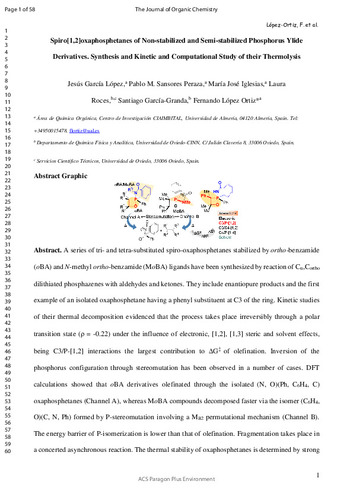Spiro[1,2]oxaphosphetanes of Nonstabilized and Semistabilized Phosphorus Ylide Derivatives: Synthesis and Kinetic and Computational Study of Their Thermolysis
Fecha de publicación:
Versión del editor:
Citación:
Resumen:
A series of tri- and tetrasubstituted spiro-oxaphosphetanes stabilized by ortho-benzamide (oBA) and N-methyl ortho-benzamide (MoBA) ligands have been synthesized by the reaction of Cα,Cortho-dilithiated phosphazenes with aldehydes and ketones. They include enantiopure products and the first example of an isolated oxaphosphetane having a phenyl substituent at C3 of the ring. Kinetic studies of their thermal decomposition showed that the process takes place irreversibly through a polar transition state (ρ = −0.22) under the influence of electronic, [1,2], [1,3] steric, and solvent effects, with C3/P-[1,2] interactions as the largest contribution to ΔG⧧ of olefination. Inversion of the phosphorus configuration through stereomutation has been observed in a number of cases. DFT calculations showed that oBA derivatives olefinated through the isolated (N, O)(Ph, C6H4, C) oxaphosphetanes (Channel A), whereas MoBA compounds decomposed faster via the isomer (C6H4, O)(C, N, Ph) formed by P-stereomutation involving a MB2 permutational mechanism (Channel B). The energy barrier of P-isomerization is lower than that of olefination. Fragmentation takes place in a concerted asynchronous reaction. The thermal stability of oxaphosphetanes is determined by strong C3/P-[1,2] interactions destabilizing the transition state of olefination. The effect of charge distribution and C3/C4-[1,2] and C4/P-[1,3] steric and solvent interactions on ΔG⧧ was also evaluated.
A series of tri- and tetrasubstituted spiro-oxaphosphetanes stabilized by ortho-benzamide (oBA) and N-methyl ortho-benzamide (MoBA) ligands have been synthesized by the reaction of Cα,Cortho-dilithiated phosphazenes with aldehydes and ketones. They include enantiopure products and the first example of an isolated oxaphosphetane having a phenyl substituent at C3 of the ring. Kinetic studies of their thermal decomposition showed that the process takes place irreversibly through a polar transition state (ρ = −0.22) under the influence of electronic, [1,2], [1,3] steric, and solvent effects, with C3/P-[1,2] interactions as the largest contribution to ΔG⧧ of olefination. Inversion of the phosphorus configuration through stereomutation has been observed in a number of cases. DFT calculations showed that oBA derivatives olefinated through the isolated (N, O)(Ph, C6H4, C) oxaphosphetanes (Channel A), whereas MoBA compounds decomposed faster via the isomer (C6H4, O)(C, N, Ph) formed by P-stereomutation involving a MB2 permutational mechanism (Channel B). The energy barrier of P-isomerization is lower than that of olefination. Fragmentation takes place in a concerted asynchronous reaction. The thermal stability of oxaphosphetanes is determined by strong C3/P-[1,2] interactions destabilizing the transition state of olefination. The effect of charge distribution and C3/C4-[1,2] and C4/P-[1,3] steric and solvent interactions on ΔG⧧ was also evaluated.
Patrocinado por:
Financial support by the Ministerio de Ciencia e Innovación and FEDER program (projects CTQ2008-117BQU, MAT2006-01997, MAT2010-15094, PTA-2009-2346-I and CSD2006-015, Consolider Ingenio 2010, “Factoría de Cristalización”) are gratefully acknowledged.
Colecciones
- Artículos [37541]
- Investigaciones y Documentos OpenAIRE [8415]
- Química Física y Analítica [639]
Ficheros en el ítem




